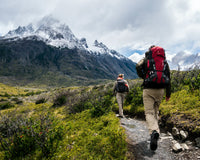There's something special about hiking alone. It's an opportunity to connect with nature in a way that's different from hiking with a group. Solo hiking can be a rewarding and empowering experience, but it also requires a bit more planning and preparation than hiking with a group. In this blog post, we'll provide some tips for solo hiking and help you get started on your solo hiking journey.
Benefits of Solo Hiking
Hiking alone can be a unique and rewarding experience. It allows you to connect with nature in a way that's difficult to do in a group setting. You can explore at your own pace and spend time reflecting on your thoughts. Solo hiking can also help build self-confidence and independence.
Of course, solo hiking also requires more preparation and planning than hiking with a group. It's important to understand the risks and take necessary precautions to ensure your safety.
Preparing for a Solo Hike
Preparing for a solo hike is a bit different than preparing for a group hike. Here are some things to consider when planning your solo hike:
-
Choose a hike that matches your skill level: When planning your solo hike, it's important to choose a trail that matches your skill level. Look for a trail that's within your ability level and that you're comfortable hiking alone. You can gradually increase the difficulty level as you gain more experience.
-
Research the trail: It's important to research the trail you'll be hiking to understand the conditions and any potential hazards. Look for recent trail reports, weather conditions, and any wildlife or plant risks.
-
Tell someone your plan: Make sure to tell someone your plan before you head out on your hike. Let them know where you'll be hiking, when you'll be back, and what to do in case of an emergency.
-
Pack for the trip: Make sure to bring all the necessary gear and supplies for your hike, including food, water, and first aid supplies. It's important to pack for the unexpected, and be prepared for changing weather conditions.
-
Bring a map and compass: A map and compass can help you navigate the trail and ensure you stay on course. Make sure to learn how to read a map and use a compass before heading out on your hike.
-
Bring a communication device: Bring a cell phone or other communication device in case of emergency. Make sure to keep it charged and have a backup power source.
-
Dress for the weather: Dress in layers and bring appropriate clothing for the weather conditions. It's important to be prepared for changing weather conditions, especially in mountainous or remote areas.
Safety Tips for Solo Hiking
When hiking alone, it's important to take necessary precautions to ensure your safety. Here are some tips for staying safe while solo hiking:
-
Stay on the trail: It's important to stay on the designated trail to avoid getting lost or injured. Avoid taking shortcuts or exploring off-trail areas.
-
Be aware of wildlife: In many hiking areas, you may encounter wildlife such as bears or mountain lions. Make sure to be aware of the wildlife in the area and take necessary precautions, such as carrying bear spray.
-
Stay hydrated: It's important to stay hydrated while hiking, especially when hiking alone. Bring plenty of water and drink regularly throughout the hike.
-
Know your limits: Don't push yourself too hard when hiking alone. Listen to your body and take breaks when needed.
-
Keep track of time: It's important to keep track of the time and plan your hike accordingly. Make sure to start early enough to avoid hiking in the dark, especially in remote areas.
-
Trust your instincts: If something feels off or you feel unsafe, trust your instincts and turn back. It's better to be safe than sorry when hiking alone.
Enjoying the Solitude
One of the joys of solo hiking is the opportunity to connect with nature in a deeper way. Here are some tips for enjoying the solitude while hiking alone:
-
Take breaks and reflect: Solo hiking is a great opportunity to take breaks and reflect on your thoughts. Take time to sit and enjoy the views, or meditate in a quiet spot.
-
Disconnect from technology: Leave your phone behind, or turn it off while hiking. Disconnecting from technology can help you connect with nature and appreciate the solitude.
-
Take photos and journal: Bring a camera or journal to capture your experience. Taking photos and writing down your thoughts can help you remember the experience and reflect on it later.
-
Be present in the moment: When hiking alone, it's important to be present in the moment and appreciate the experience. Take time to notice the details of the trail, such as the colors of the leaves, the sounds of the birds, or the feel of the breeze on your face.
Conclusion
Solo hiking can be a rewarding and empowering experience, but it also requires more preparation and planning than hiking with a group. By understanding the risks and taking necessary precautions, you can ensure your safety and enjoy the solitude of the trail. With proper planning and a sense of adventure, solo hiking can be an unforgettable experience that will stay with you for a lifetime. So, get out there and explore the wilderness alone, and discover the beauty of the great outdoors in a new and unique way.









